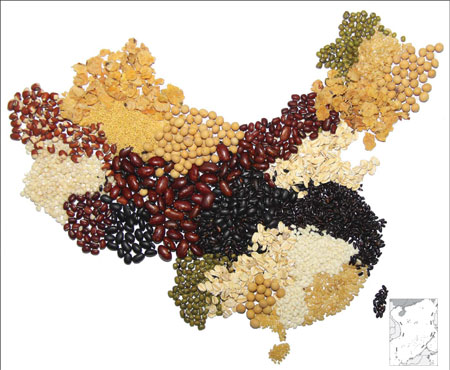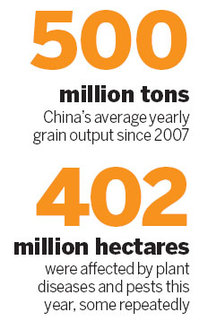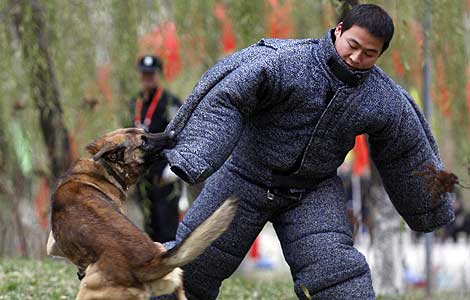Feeding China
Updated: 2011-12-04 07:43
By Jin Zhu (China Daily)
|
|||||||||


China's autumn harvest surpassed expectations this year, despite a constant battle with droughts, floods and pests. China Daily agriculture reporter Jin Zhu looks at how the world's most populous country makes sure it has enough to eat, and enough to help feed the world.
China's total output for grain this year hit a record high of 571 million tons, making it the eighth consecutive year production has exceeded forecast. More than 70 percent of this increase is expected to come from Northeast China, due to unusually favorable weather conditions, according to the Ministry of Agriculture. But agricultural experts are warning that the fat years may not continue, especially if grain production is too concentrated in the northern arable lands.
"Good weather does not occur every year. When and if natural disasters hit these major crop-producing areas, the impact will be great," Lu Bu, a researcher in agricultural resources and regional planning at the Chinese Academy of Agricultural Sciences (CAAS) told China Daily.
Even as China battles more frequent floods, droughts and pestilence brought about by climate change, the world's attention is focused on how this vast country manages to stay self-sufficient in grain. And it has succeeded, despite the doomsayers, and despite the natural disadvantages.
For instance, by August, prolonged drought had affected more than 4.5 million hectares of crops, of which 71 percent were concentrated in Guizhou, Hunan, Yunnan and Inner Mongolia autonomous region, ministry statistics show.
Li Maosong, a CAAS researcher on disaster reduction, tells China Daily that drought is responsible for more grain loss than any other natural disaster.
"Nearly 60 percent of grain loss is caused by drought. The other main causes are floods, plant diseases and insects," he says.
Another area of growing concern is the serious increase in pests in recent years. According to the Ministry, total arable land hit by diseases and insects is expected to reach 402 million hectares, a result of global warming and the catastrophic drought this year.
(Note: The same area may be affected several times in a year, which increases the total count.)
"Plant diseases and insects are more serious this year compared to the average annual affected areas of 268 million hectares in previous years," Li says. Red wheat mites and aphids attacked most of the country's wheat-producing areas this year and the situation is worsening, according to the ministry. Li notes that around 15 percent of the grain harvest is lost to plant diseases and insects every year.
"But the impact is still limited for the country as a whole." The curtailed impact is the result of precise monitoring, and timely intervention, and better management translates to better harvests.
Despite frequent extreme weather and the shrinking of arable land, China's annual grain production has remained above 500 million tons since 2007. Much of it is due to the silent teams of researchers who work tirelessly to improve crop yields and reduce pestilence.
"Support by the central authorities and advanced technology are the decisive forces in driving the country's grain output," Li says
In 2010, the total grain-producing area in China was boosted to 109.5 million hectares, a year-on-year increase of 470,000 hectares, official figures show.
Scientific research on crops goes on in tandem with the constant search and supply of good seeds and the continuing education of China's farmers in advanced cultivation methods.
For instance, a pilot program on water conservation, launched by the Chinese Academy of Agricultural Sciences, is now under way in Northwest China's Gansu province, where about 70 percent of the cultivated area cannot be irrigated due to chronic water shortage.
Under the pilot program, farmers are taught to cover dry land with plastic sheets that collect rainwater and condensation, minimizing water loss. As a result, the corn yield per hectare in Gansu has reached 8.9 tons, up from the country's average yield of 5.2 tons.
According to ministry projections, the country's total grain demand will reach 572.5 million tons by 2020, an increase of 47.5 million tons compared to 2010. To make sure the target is met, more scientific research will strengthen China's ability to feed itself.
That is why China is looking abroad for cooperation, exchanges and assistance.
In April, a joint laboratory for agricultural research was launched in Beijing with an agenda to study genetic resources, animal husbandry, veterinary science, agro-ecology, and environmental science. It was the first agricultural lab set up between China and Brazil.
A twin cooperative center is to be built next year in Rio de Janeiro, which will be the first agricultural program by China off-site.
Beijing plans to set up nine other such joint laboratories with more countries, including the US, Canada, Germany and Russia.
Tang Huajun, the deputy dean of the CAAS, says it is part of the effort to strengthen international agricultural scientific cooperation.
"Besides realizing its promise of self-sufficiency, China is also helping to feed more countries abroad, particularly through food aid in recent years," US Agriculture Secretary Tom Vilsack said during a visit to the China Agricultural University last month in Beijing.
In 2010, more than 900 million people worldwide suffered from malnutrition and hunger, up from 800 million in 1995, according to the United Nations Food and Agriculture Organization.
It is not just through food aid that China is helping to feed the world.
Chinese produce is also exported, and Food Rules author Michael Pollan commented at the US-China Forum held in Beijing recently that "more and more Americans are eating from Chinese soil", referring to frozen vegetables from China now commonly found in American supermarkets.
Most of it is labelled organic, and Pollan says the branding must be government supported to eradicate any doubts on the part of the American consumer.
Otherwise, the organic label will become valueless, just as the "natural" label used by American producers have lost its meaning.
The world needs to increase its food production by 70 percent by the year 2050 in order to feed a projected population of 9.3 billion, Vilsack said.
"Both China and US have the responsibility to ensure the world's future food safety, by relying on their scientific researches, such as developing disaster-tolerant seeds and advanced planting method," he said.
Li Yao contributed to this story.
You can contact the writers at sundayed@chinadaily.com.cn.
(China Daily 12/04/2011 page1)











